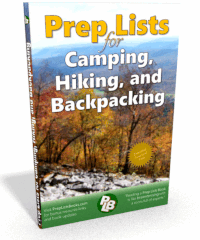A section in Chapter 2 of the book:
Prep Lists for Camping, Hiking, and Backpacking
To replace or supplement the fresh water that you brought with you, here are some ideas for finding water in the wilderness.
Remember that all water found in nature should be purified before drinking.
On the Move
- Go downhill into valleys to find streams and ponds
- Stop and listen for running water from distant rapids or falls
- Follow the beds of seasonal streams to find water pools
- Follow rocky canyons to find pools of rainwater
- Follow merging game trails & tracks that may lead to waterholes
- In dry or rocky areas, look for green plants to find water
- In a dry riverbed, look for green plants to locate damp earth
- In a dry riverbed, look for drinking holes dug by thirsty animals
When possible, take water from a moving stream or waterfall
rather than a standing pool or pond, which is much more likely to have contaminants.
Characteristics
For the best quality—or least contaminated water, look for these characteristics.
- Moving or flowing rather than standing or stagnating—this makes it less hospitable to pathogens.
- Bubbling, gurgling, or ripping rather than smooth flowing—this oxygenation helps to purify it.
- Passed through vegetation like reeds, grass, and moss—this does extensive filtering of phosphorous, nitrates, and foreign matter.
- Near the top of standing water—this layer is the most exposed to the ultraviolet rays of sunlight, which kills germs.
Extraction
- Use a string and a water bottle to collect a slow drip from a cliff.
- Create a straw to suck water out of cracks and crevices.
- Dig a small well in a dry stream bed to find a lower water table; often when a stream is dry, water continues to flow beneath the surface.
- Soak a cotton cloth or t-shirt with morning dew on grass, trees, and other plants; then squeeze the water from the cloth into your mouth (or container) and repeat. You can use your hands or tie to your ankles and simply walk through wet
- Tightly wrap a large plastic bag over a green, leafy tree branch or any leafy vegetation to trap moisture as it evaporates, and then condenses on the inside of the plastic bag.
Vegetation: If your purpose for looking for water is to drink it,
remember that many fruits, berries, and vegetables have water in them.
Collection
Collect rain water by redirecting from a large surface to a narrow collection point.
- Spread or hang a tarp, raincoat, jacket, blanket, tent, or other material with a valley in the middle (A “V” shape) to direct rain water into a container (remember to account for wind direction).
- If you don’t have a container to store the rain water, tie ends of your collector sheeting up so that it holds water in the middle
- Find a location under the trees where rain water is drizzling the most and place your container under it.
- Construct a large “roof” of wood, leaves, and grass to capture and direct rain water into a container (or your mouth).
- Hang large, absorbent material (blanket, clothing, bed sheets, etc.) to soak up falling rain and wring into a container—repeating as needed.
- Gather snow and ice that will melt by the fire—ideally in a cloth sack like a pillowcase, which can be suspended over a container to collect the dripping water as it melts.
A 10’ × 12’ tarp can collect over 50 gallons of water from one inch of rain.
} } } This information is in the book “Prep Lists for Camping, Hiking, and Backpacking.” { { {


You must log in to post a comment. Log in now.